Mushrooms
Media
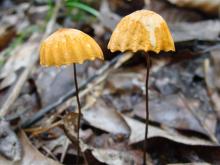
Species Types
Scientific Name
Marasmius siccus
Description
The orange pinwheel marasmius is a tiny mushroom with an orange, bell-shaped, pleated cap, white gills, and a skinny brownish stalk. It grows scattered to many on dead leaves, wood, and twigs of deciduous trees.
Media
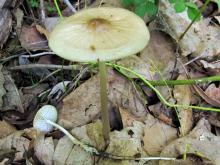
Species Types
Scientific Name
Xerula furfuracea (Collybia radicata var. furfuracea)
Description
The rooted collybia has a moist, wrinkled, grayish brown flat cap and a long, slender stalk that continues underground. It grows singly or scattered on and around deciduous trees and stumps.
Media
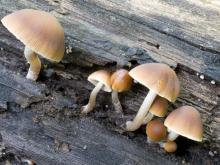
Species Types
Scientific Name
Various species of confusingly similar mushrooms
Description
Like the LGBs (“little gray birds”) of the birdwatchers, this is a catchall category. It includes all the small to medium-sized, hard-to-identify brownish mushroom with spores of all colors. There are many hundreds of species that fit this description!
Media

Species Types
Scientific Name
Urnula craterium
Description
Devil's urns are goblet-shaped, leathery brown cups. They grow in clusters on small to medium-sized decaying branches of hardwoods, especially oaks. Look for them in spring.
Media

Species Types
Scientific Name
Galiella rufa (formerly Bulgaria rufa)
Description
The hairy rubber cup has a reddish to brownish inner surface; the outside is blackish brown and hairy. It grows in clusters on dead deciduous wood.
Media

Species Types
Scientific Name
Sarcoscypha occidentalis
Description
The stalked scarlet cup is, indeed, a tiny red cup on a tiny white stalk. It grows scattered on fallen wet sticks and branches in damp deciduous woods.
Media

Species Types
Scientific Name
Laetiporus sulphureus
Description
Sulfur-colored chicken of the woods is an edible fungus with layered, fan-shaped, fleshy caps that are orange on top and sulfur yellow below. It grows in overlapping clusters on stumps, trunks, and logs of dead or dying deciduous trees, and on living trees and buried roots.
Media
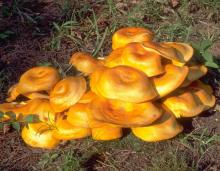
Species Types
Scientific Name
Omphalotus illudens (formerly O. olearius)
Description
Jack-o’-lanterns are bright orange to yellowish orange, with sharp-edged gills that descend the stalk. They grow in clusters, at the base of stumps, and from buried roots of oak and other deciduous wood.
Media
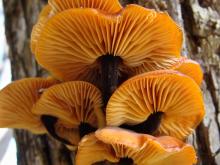
Species Types
Scientific Name
Flammulina velutipes
Description
The velvet foot, or enoki, has a tawny, sticky cap with whitish gills. The stalk is yellowish above and brownish below. They grow in clusters on deciduous logs.
Media
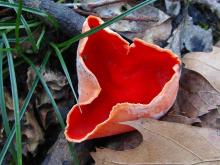
Species Types
Scientific Name
Sarcoscypha dudleyi
Description
The scarlet cup is small, red, and usually stalkless, with a white outer surface. It grows on fallen wet sticks and branches in damp deciduous woods.
See Also



Media

Species Types
Scientific Name
Monotropa hypopitys
Description
Pinesap is a plant that puts the "wild" in wildflower! It lacks chlorophyll, so its roots connect to fungi underground and absorb nutrients from the fungi.
Media

Species Types
Scientific Name
Cladophora, Pithophora, and Spirogyra spp., and others
Description
Filamentous green algae forms green, cottony masses that are free-floating or attached to rocks, debris, or other plants.
Media

Species Types
Scientific Name
Monotropa uniflora
Description
Indian pipe lacks chlorophyll, so it is white, not green. Below ground, its roots join with fungi that connect to tree roots. This plant, then, takes nourishment indirectly from the trees.
About Mushrooms in Missouri
Mushrooms are a lot like plants, but they lack chlorophyll and have to take nutrients from other materials. Mushrooms are neither plants nor animals. They are in a different kingdom — the fungi. Fungi include the familiar mushroom-forming species, plus the yeasts, molds, smuts, and rusts.
Always be cautious when eating edible mushrooms. Be absolutely sure of the ID, and only eat a small amount the first time you try it to avoid a reaction..





















